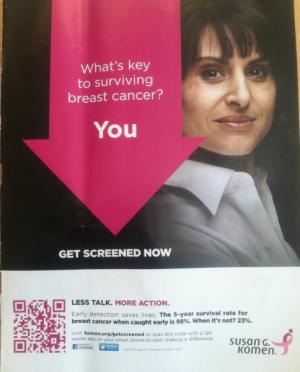What Doctors Don't Know & Journalists Don't Convey About Screening May Harm Patients
A paper in the Annals of Internal Medicine this week asked (and partially answered): "Do Physicians Understand Cancer Screening Statistics?"
The authors – familiar names like Woloshin, Schwartz, Gigerenzer – are from the Harding Center for Risk Literacy at the Max Planck Institute for Human Development in Berlin and from the Dartmouth Institute for Health Policy and Clinical Practice.
It's a shame this paper isn't freely, publicly available to all readers because it may help explain some of the foundation of the dilemma we face in this country about miscommunication about the tradeoffs involved in screening tests.
" three-quarters of the more than 400 doctors surveyed believed better survival rates prove screening is a lifesaver although that's not the case, researchers say.
And nearly half thought early detection translates into saving lives - another common misperception.
"This is really unfortunate because one of the things we always say is, ‘Discuss it with your doctor,'" said Dr. Otis Brawley, chief medical officer of the American Cancer Society. "This is evidence that your doctor doesn't know."
Brawley, who wasn't involved in the new survey, said the lack of statistical sophistication among doctors is part of the reason why prostate cancer screening, now a controversial practice, has become so widespread.
"Misunderstanding of statistics has been fueling a great deal of screening," he told Reuters Health. "Unfortunately we have all been taught that the way to deal with cancer is to find it early. As we have learned more and more about cancer, we are starting to find that that's not true."

Dr. Steven Woloshin, of Dartmouth Medical School in Hanover, New Hampshire, who worked on the new survey told Reuters Health that death rates gleaned from clinical trials are the only reliable way to judge if a screening test is effective. But organizations that promote screening, such as the breast cancer charity Susan G. Komen for the Cure, tend to prefer survival rates, which sound more impressive.
(Editor's note: A copy of one such promotion by Komen appears at right. Woloshin uses this example in talks he gives to train journalists.)
And Dr. Virginia Moyer of Baylor, also chair of the US Preventive Services Task Force, wrote an accompanying editorial, "What We Don't Know Can Hurt Our Patients: Physician Innumeracy and Overuse of Screening Tests." In it, she mentioned our work:
"Excellent work on how to effectively communicate statistical data to both patients and physicians has been done, but more is needed. Work of this sort is being supported by the Agency for Healthcare Research and Quality and such groups as the Foundation for Informed Medical Decision Making. To temper the unbridled enthusiasm of patients for screening tests, and especially for cancer screening, we need to reach beyond medicine to the public, which of course gets a substantial amount of medical information from the media. Educational efforts should focus not just on medical students and physicians but also on journalists. Several medical journals have taken the lead in making it easier for journalists to get the statistics right and to recognize the limitations of the studies they report. Watchdog groups, such as HealthNewsReview.org, help to monitor press reports and should be encouraged to add interpretation of screening statistics to the criteria they use to assess health news stories."
Dr. Moyer may not be aware that we already do apply our criteria to stories that make claims about screening tests. (Some of these criteria-driven story reviews show up on a search of our site. Far more often, we comment on our blog about stories, ads, news releases, public relations efforts, advocacy/awareness campaigns and marketing that discuss screening tests. A search of our blog turns up many such items.)
Surprisingly (maybe not so surprisingly) few mainstream news organizations picked up on the important Annals paper and editorial. We scratch our heads at this, but, as we often do, we point to a clear pattern of pro-screening bias and advocacy on the part of many news organizations. We don't think they do so with any malice; they simply don't grasp the importance of the topic, nor the fact that there are tradeoffs, that screening tests do cause harm, and that screening should be a decision, not a mandate.
As the Annals papers show, the confusion, misunderstanding and miscommunication may start with many doctors. Journalists and other public messengers may only make it worse. Dr. Moyer chose an appropriate title for her editorial:

